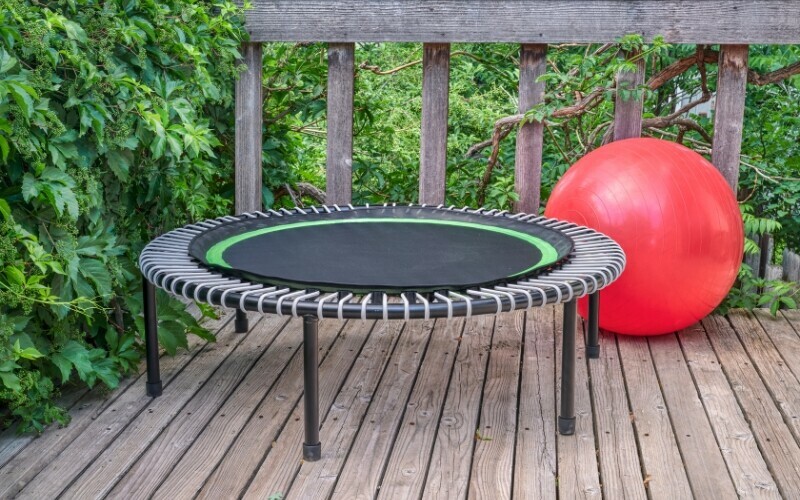Are you looking for a fun, low-impact way to support your immune system and improve your overall health? Rebounding—bouncing on a mini-trampoline—might be just what you need. There are many rebounder health benefits. This simple exercise not only gets your heart pumping but also helps a vital part of your body: the lymphatic system.
Understanding the Lymphatic System
The lymphatic system plays a major role in keeping your body healthy.
It’s like the body’s drainage system, helping to remove waste, toxins, and other unwanted materials.
Unlike your circulatory system, which has the heart to pump blood, the lymphatic system relies on your movement to get fluid moving.
Without enough movement, your lymphatic system can become sluggish, leading to swelling, discomfort, and even a weakened immune system.
Rebounding is a simple exercise that’s great for your whole body.
It gets all your cells moving and helps your immune system stay strong.
There are many rebounder health benefits involving your lymphatic system.
It is not necessary to rebound every day. Using it 3 to 5 times a week for just 10 to 15 minutes a day, can make a big difference in your health.
So, What Exactly is a Rebounder?
A rebounder – mini trampoline is a small, portable trampoline designed for individual exercise.
It typically has a sturdy frame and elastic mat, providing a low-impact workout that improves cardiovascular health, balance, and strength.
Ideal for gentle exercises, it’s commonly used in fitness routines and physical therapy.
| Rebounder | Description |
|---|---|
| Cellercise® Rebounder | 40” diameter, 400 lb weight limit, foldable legs, patented TriDaptable® springs. |
| JumpSport 350/350f/370 Indoor Fitness Trampoline | 39” diameter, 275 lb weight limit, silent bungee cords, no-tip legs, 3 adjustable tension settings. |
| Standard Rebounder by Rebound Air | 40” diameter, 300 lb weight limit, folding legs, patented metal springs. |
This post contains affiliate links. If you click on and purchase through one of those links, you won’t pay a penny more, but we’ll get a small commission, which helps keep our website operating. Thanks! As an Amazon Associate, I earn from qualifying purchases.

So, how can rebounding help? Let’s dive into the benefits.
Rebounding and Lymphatic Circulation
When you bounce on a rebounder, the up-and-down motion helps to stimulate your lymphatic system.
This happens because your lymph fluid moves when your muscles contract.
While you are Rebounding, gravity assists in creating a natural “pump” for your lymphatic system, allowing it to work more efficiently.
According to research, gentle bouncing can increase lymph flow by 15-30 times, helping your body flush out toxins and waste.
This is why rebounding is often called a “detoxifying” exercise.
Two Minutes Bouncing on a Rebounder
Bouncing helps this process by opening and closing valves in your lymphatic system. This helps clean out the waste from your cells.
In only two minutes you can flush the entire lymphatic system and strengthen the cells and lymph nodes.
This leads to a triple increase in white blood cell count, which remains elevated for up to an hour (MedFitNetwork).
Rebounder Health Benefits for the Lymphatic System
Rebounding doesn’t just get your lymph moving—it brings several important health benefits, especially for your immune system and overall well-being
1-Detoxification
Bouncing on a rebounder helps the lymphatic system clear out waste from cells, supporting the body’s detoxification process.
This means fewer toxins in your system and better overall health.
Think of it as giving your body a gentle cleanse every time you bounce.
This is especially beneficial for people with conditions like lymphedema, where proper lymphatic drainage is critical (MedFitNetwork).
Little Clean-Up Crews
Lymphocytes are a type of immune cell that is made in the bone marrow.
They are like little clean-up crews that get rid of waste and fight off germs.
Rebounding keeps your lymphatic system working well, so those cells can do their job properly.
2-Reduced Inflammation
A well-functioning lymphatic system helps reduce inflammation in the body.
By improving lymph flow, rebounding can help reduce the swelling and discomfort caused by fluid buildup.
A study published in PubMed has shown that good lymphatic health is linked to lower levels of inflammation.
3-Boosted Immune System
Your immune system is like your body’s defense team, and the lymphatic system is its transportation system.
Since the lymphatic system is responsible for circulating white blood cells, rebounding can help your immune system work more efficiently.
When the lymph moves freely, white blood cells can do their job better, helping to fight off infections and keeping you healthy.
Regular rebounding can enhance your body’s immune surveillance, meaning it will be quicker to respond to invaders like viruses or bacteria.
Other Benefits of Rebounding Beyond Lymphatic Health
In addition to its positive effects on the lymphatic system, rebounding offers many other health benefits.
1-Low-Impact Cardiovascular Workout
Rebounding is a great way to get your heart rate up without putting stress on your joints.
It’s a low-impact exercise, meaning it’s easy on your knees and hips, making it ideal for older adults or those with joint issues.
2-Improved Balance and Coordination
Regular rebounding helps strengthen the muscles that support balance and coordination.
It engages your core muscles and improves your body’s stability, which can be especially beneficial as we age.
Gentle on Your Body
The best part about rebounding is that it’s gentle on your body.
You don’t have to worry about hurting your hips, knees, ankles, or shins.
Safe and Effective
Use it for 10 minutes every day or even multiple times a day without hurting yourself.
(Don’t over-do it, however, when you are first starting out – like the lady who did over a half hour at one time and was quite sore afterwards.)
It’s a safe and effective way to stay healthy and active, especially as you get older.

How to Incorporate Rebounding into Your Routine
Getting started with a rebounding routine is easy. All you need is a rebounder (mini-trampoline) and a few minutes of your day.
Here are some simple tips to help you begin:
- Safety First: If you have any health concerns, consult with your doctor before starting rebounding exercises.
- Start Slow: Begin with 10-15 minutes of gentle bouncing per day. Even light bouncing can stimulate your lymphatic system.
- Focus on Form: Keep your knees slightly bent and your feet shoulder-width apart to maintain balance.
- Stay Consistent: Try to rebound at least three times per week for the best results.
Rebounder Health Benefits
Rebounding is more than just a fun exercise—it’s a powerful way to support your lymphatic system.
It boosts your immune health, and helps your body detoxify.
With benefits ranging from improved lymphatic drainage to better balance and joint-friendly cardio, it’s an excellent choice for people of all ages, especially those looking for a gentle, effective workout.
So, are you ready to bounce your way to better health? Give rebounding a try and start feeling the difference today!
Sources and References
- PubMed. “The Role of the Lymphatic System in Immune Function and Inflammation.”
- Mayo Clinic. “Lymphatic System: Function and Disorders.”
- Walker, M. “Rebound Exercise: The Ultimate Exercise for the New Millennium.”

You Do the Pumping
The pulsing of nearby arteries and squeezing of nearby muscles help fluid move through your lymphatic vessels. The rebounder is an excellent tool to help you move your lymph!
Benefits of Rebounding
1. Strengthens Musculoskeletal Systems.
2. Strengthens Heart and Muscles.
3. Increases Oxygen Circulation to Your Cells.
4. Enhances Respiration Capacity with Deeper Breaths.
5. Promotes Red Blood Cell Production in the Bone Marrow.
6. Boosts Metabolism.
7. Enhances Circulatory and Lymphatic Systems.
8. Improves Coordination and Balance.
9. Longer Jumping Sessions increases Your Endurance.
Remember, it’s smart to talk to a doctor or fitness expert before starting any new exercise routine, especially if you have health issues. They can give you advice tailored to your personal situation and needs.
Disclaimer: If you have any concerns or questions about your health, you should always consult with a physician or other healthcare professional. No content on this site should be substituted for direct medical advice from your doctor or other qualified healthcare practitioner. The information contained here is for informational purposes only. It is from my research and personal experience.
Related Posts
What is the Best Mini Trampoline for Your Fitness Routine?
Beginner Mini Trampoline Workout Benefits
Rebounding and Cellulite – Fact and Fiction
Trampoline History Facts and Benefits

